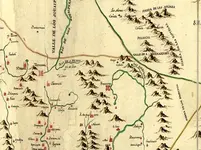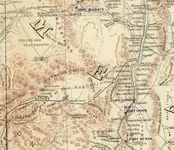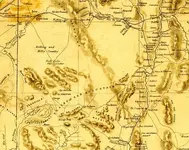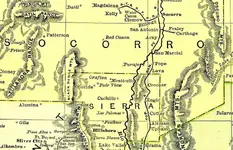Old Bookaroo
Silver Member
- #1
Thread Owner
Echoes From Lost Mines
By Jim Dan Hill
Overland Monthly and Out West Magazine - February 1924
By Jim Dan Hill
Overland Monthly and Out West Magazine - February 1924
A certain famous novelist is being taken seriously in certain financial circles of New York, if the report is true that the primary purpose in the organization of the Canada del Oro Mining and Prospecting Company is to search for the lost Arizona mine, about which is builded the plot of Wright’s latest novel, “The Mine with the Iron Door.”

Joseph Ramon de Urrutia: Primera Parte del Mapa, que comprende la Frontera, de los Dominios del Ray, en la America Septentrional: 1771
It is said that scouts from the New York concern are already in the Santa Cataline Mountains, looking for the mine that Wright made famous, as well as for a number of other “lost diggings,” to the whereabouts of which the padres in the ancient St. Xavier Mission are alleged to have a clue. Whether they do or not is to be learned. Nevertheless, the mission is to receive on eight of all gold that is found.
Perhaps the project looks good to the northern investors, but the same cannot be said of the ancient prospectors of the old Southwest who make Socorro, New Mexico, one time mining capital of the border states, their rendezvous from the alkaline deserts. One has but to listen to the oracle-like mutterings of Diorite Dawley, Lead Ore Levi or Windy Bill Wilgus to draw that conclusion.
That these three gentlemen are qualified to speak with authority is not to be questioned. Has not Mr. Dawley, according to his own admission, panned for colors in every gulch between Tierra Del Fuego and Point Barrow? While Mr. Levi is not so experienced, he is a veteran prospector nevertheless; and, as his name indicates, he is an authority on the heavy yellow metal whether it be in the form of a nugget or the case of a watch. Unlike the other two, Windy Bill is more of a historian than a knight of the pan. He claims to be the one and only living authority on the Southwestern mining lore of yesteryear, which statement it is assumed, definitely excludes Harold Bell Wright.
“Gold in the Santa Catalines!” exclaimed this trio from their favorite bench on the sunny side of the plaza when the news of the operations of the new company reached their ears. “Why doesn’t this Del Oro Company look up in the Mal Pais of New Mexico, where the honest to God yellow stuff lies in placer pockets as big as barrels!”
“Is there a ‘lost mine’ up there?” inquired an uninitiated.
“I’ll tell the world there is,” responded Mr. Dawley. “The Adams Diggings are there. It is the only authenticated ‘lost mine’ in the Southwest.”
Silent, affirmative nods from the other two indicated that the statement of their loafing partner was backed, scotched and supported by their professional reputations.
“Did you ask where these diggings are? Stranger, that is hardly a fair question. If I knew exactly where they are, I’d be dipping up the gold nuggets myself, without hoping for the aid of one of these big syndicates. I could carry the Del Oro’s expedition to the bones of the main body of Adam’s party and that is close enough for a big company to locate a placer. I would do it for less than an eighth, believe me.”
There were no nods of approval this time, for, it was revealed later, they too knew the location of the bones in question, and if any one of the three were right it would make the other two from ten to twenty-five miles wrong.
Diorite’s faith in Windy Bill’s loquacity was well founded, for it took that worthy exactly three hours, not counting time out for corrections, from his cronies, to get the story off his chest.
Sometime between ’58 and ’62, the trio refused to agree upon the same date, a certain Mr. Adams provided pack animals for a party of prospectors, who, under the leadership of an Indian, were going from southern Arizona to west central New Mexico in search of a stream that flowed out of a box canyon, the bed of which was literally yellow with gold. In return for the animals, Adams was allowed to join the party. The journey ended up in the edge of the lava flows about one hundred miles southwest of Albuquerque and near the line that today separates Valencia from Socorro county. Here was found the box canyon creek the wealth of which far exceeds the fabulous representations of the Indian guide.
Hardly had the work of washing out the gold begun when clouds of trouble appeared on the horizon. The provisions were running alarmingly low and at the same time the surrounding Indian tribes were showing signs of hostility, in spite of the efforts of the white party’s guide. This was the condition of affairs when eleven of the prospectors started for Fort Wingate, about two days, burro time, to the northwest, which left Adams and about nine others in the canyon.
On the fifth day after their departure, Adams and a friend by the name of Davis, climbed to the top of a nearby mesa, to see if the returning caravan was in sight. They saw it emerging from a gap in the neighboring range of mountains, but even as they watched, a band of Indians swooped down upon it and murdered the entire party. The redskins then attacked the men in the canyon, who suffered the same fate as the pack train guard. Believing that not a one of the prospectors remained alive, the savages withdrew which permitted the two men on the mesa to escape under cover of the fast approaching darkness.
Several years later Davis died in New Orleans, but Adams was next heard of in Los Angeles, where he published a book telling of his adventures, the fate of his party, and the native wealth of the box canyon. The book caused quite a sensation, and Adams was staked a number of times to lead other expeditions to the diggings. None, however, succeeded in reaching the lost Eldorado.
The last of these expeditions left Tucson in the early ‘90’s and reached the Mal Pais without mishap, but Adams could not find the canyon. On account of his failure, Mr. Robert Lewis, at present deputy sheriff of Socorro county, and who, by the way is a real authority on New Mexico history, had to spirit Adams away to keep him from being lynched by his disappointed companions. It might be well for Mr. Wright and the St. Xavier fathers to keep this last fact in mind while guiding the Del Oro party.
Why was Adams unable to return to the diggings?
Mr. Dawley explained that immediately after Adam’s escape from the Indians, he almost died from an attack of typhoid fever which left his memory more or less muddled. It was Mr. Levi’s belief that because Adams was pack master of the original expedition, he was always at the rear of the train and did not see the landmarks ahead; while Windy Bill was of the opinion that Adams knew where the canyon was but wanted to go back to it alone and garner all the nuggets for himself.
It is to be hoped, nevertheless, that when the Del Oro people have accomplished their purpose in the Santa Catalines, they will comb the Mal Pais. Even though they do not find the Adams Diggings, they should round up enough stories concerning them to provide Mr. Wright with material for another novel. Thus the work of the expedition cannot be a total loss either way.
-- oo0oo --
Editor’s Notes: This article was published in the famous Overland Monthly. It is cited in J. Frank Dobie’s essential Lost Adams bibliography (“Where I Dug for Adams Gold” - Apache Gold and Yaqui Silver (1928). Probert’s generally reliable Lost Mines and Buried Treasures of the West (1977) lists it under the “The Mine with the Iron Door” but not under the Lost Adams Diggings (and he has no listing for Lost Escalante. Probert notes John W. Pounds reprinted this piece in Treasure Hunter, Vol. 6, No. 4. I believe this is the first time this article has been made available since then - and good luck locating any back issues of Johnnie Pounds’ excellent magazine!
Writers such as Mark Twain, Ambrose Bierce and Jack London saw their work published in The Overland Monthly; Bret Harte was its first editor. Josephine Clifford McCracken was first published in this magazine. Her fascinating articles on US Army life in the American West, told from a wife’s perspective, are far too little known today. She was instrumental in saving California’s redwood forests.
The Mine with the Iron Door, by Harold Bell Wright (1923) was a popular novel in its day. It was made into a silent Western in 1924. It is generally believed to be pure fiction, although in the tradition of so much lost treasure literature that hasn’t stopped many writers from borrowing from it. The yarn is an old one - Spanish padres developed a rich mine with Indian slave labor and didn’t live to spend their ill-gotten gains. The unique feature (the “tell,” if you will, for identifying authors who have plundered the novel in their “research”) is the old iron door that covers the mine’s entrance.
It would be a serious mistake to neglect the excellent work of Jesse (Ed) Rascoe (Ed Bartholomew) when it comes to any Western lost mines. He doesn’t disappoint. In Western Treasures Lost & Found (1971) he references the old WPA Arizona; A State Guide (as does KvonM). Here is the Father Escalante yarn, Mission San Xavier del Bac, gold ore mined and smelted into bars, and the tremendous cache hidden behind an iron door.
However, Rascoe goes on to quote some 19[SUP]th[/SUP] newspaper articles (published well before Mr. Wright’s novel) that indicate there might be fire behind the smoke of legend (see pages 12-15).
The Editor can’t resist pointing out that some “authorities” on the history of the American West, who will argue every minor point in every gunfight that ever took place, check their skepticism (and common sense) at the bar when it comes to lost treasure legends. True [!] West Magazine, in the November 2013 issue, ran an absurd tale about “Belle Starr’s Lost Iron Door Cache.” Leaving aside the obvious that when it came to actually being a successful outlaw Ms. Starr was a dim light, indeed, this wild yard contends she and her gang stopped a train with gold ingots headed for the Denver Mint. The year is pegged as “during the mid-1880s.” It will come as no surprise to some the writer of this windy was W.C. Jameson.
Here’s the silliest part (which is saying something about this story in particular and the entire article in general). The outlaws removed one of the iron doors from a railroad car (how long would that take? What tools did they use?) and using ropes, dragged the door along behind them as they made their escape on horseback.
Apparently their trusty steeds weren’t burdened enough with their plunder of gold ingots. These daring horseback bandits thought they needed an iron door! Perhaps they just wanted to leave a pursuing posse no doubt about their trail away from their crime.
I’m guessing the average cowboy’s lariat would have snapped just as soon as the hoolihan hit the door handle and the line drew taught. If it didn’t pull the outlaw and his saddle with a busted cinch right off his horse and into the dust. Or snap off the horn like the head of a match. I very much doubt the iron door would have budged five feet.
Obviously Ms. Starr and her gang didn’t need to spend their loot. The joy of obtaining it was enough for them!
Mr. Jameson continues “A short time after the robbery, railroad detectives learned of the possibility that the gold had been hidden in the Wichita Mountains. Though they hunted for weeks, they were never able to find it.”
“Detectives” who can’t follow the trail of an iron door (what would such a thing weigh? Two hundred pounds? Or more?) dragged across the prairie and into the mountains are hardly worthy of the name. It would be only slightly less difficult to follow than a road grader.
Mr. Hill states Adams published a book telling of his adventures. I don’t think that is correct. I suggest Mr. Hill was referring to the essential work by W.H. Byerts “GOLD: The Adams Gold Diggings” (1919) a little publication with a particular place in my heart because it was my first published reprint - the only edition since the original saw the light of day some seven decades before. Copies of the original are impossible to locate. Indeed, my edition has become somewhat hard to find. I have a few copies remaining - any TreasureNet reader is welcome to inquire about purchasing one.
Last edited:








